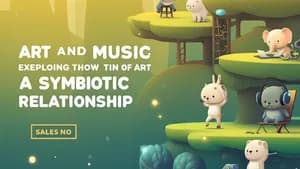Introduction: Where Art and Music Meet
Have you ever been captivated by a performance, where the music seemed to weave a spell, transporting you to another world? You weren't just watching a dance, you were witnessing a story unfold through movement and sound. This is the power of performance art, where music and visual art merge into a mesmerizing symphony of expression. Imagine a dancer's body tracing the contours of a melody, or a musician crafting a soundscape that evokes a specific emotion, all within the framework of a performance. This unique synthesis is where the boundaries between art forms dissolve, creating a deeply impactful experience for the audience.
Music as a Catalyst: Setting the Stage for Expression
Music is the heartbeat of a performance, providing the emotional framework and rhythm for visual art to come alive. It doesn't merely accompany the performance; it informs, shapes, and elevates the artistic experience. Think of the classical ballet, where Tchaikovsky's soaring melodies inspire graceful leaps and fluid movements. The music provides a narrative structure, guiding the dancer's interpretations and enhancing the storytelling aspect. This is where the music becomes a powerful tool for evoking emotions, creating tension, or conveying specific ideas. You'll find that the music can be used to create a sense of drama, highlight a moment of vulnerability, or propel the narrative forward.
In contemporary performance art, music often takes center stage as a form of visual art itself. Think of installations where sound is the primary medium, creating a dynamic and immersive experience for the audience. These installations challenge traditional notions of what constitutes art and music, blurring the lines and creating a unique sensory experience. This is where the power of music to evoke emotions and create a specific atmosphere comes into play. Imagine an installation with pulsating lights and ambient sounds, or a performance where the music interacts directly with the audience, drawing them into the experience.
Movement and Sound in Dialogue: A Dance of Expression
Traditional dance forms like ballet, Bharatanatyam, and Flamenco demonstrate the symbiotic relationship between music and movement. The choreography is intricately linked to the musical score, where every step, gesture, and expression is informed by the rhythm and melody. This intimate connection between the dancer and the music creates a harmonious dialogue, where the music guides the movement and the movement amplifies the music. This is where your understanding of the connection between music and performance can be truly impactful.
As you delve deeper into the world of dance, you'll notice the importance of musicality. You'll learn to interpret the music through your body, letting the rhythm and melody guide your movements. You might find that the music inspires you to explore different forms of movement, from intricate footwork to graceful extensions, all contributing to a holistic artistic experience.
Breaking Barriers: New Frontiers in Performance Art
Contemporary performance art pushes the boundaries even further, integrating elements of technology, multimedia, and interactivity. We see artists using music as a foundation for experimental installations, incorporating elements of sound design, digital manipulation, and audience participation. These innovative approaches challenge conventional art forms and encourage audiences to think critically about the role of music in performance art. These collaborations can be seen in interactive installations, where audiences can manipulate sound and light elements, or in performances that utilize real-time projections and live music to create a dynamic and immersive experience.
The Power of Synthesis: Learning from Music and Performance
Whether you are a student interested in visual arts, music, or even creative writing, understanding the interplay between music and performance art can be invaluable. This knowledge can enhance your own creative expression, deepen your appreciation of different art forms, and equip you with a unique perspective on the world. Here are some tips to enhance your understanding:
-
Engage with different forms of performance art: Explore various forms, from traditional dance to contemporary performance installations. Seek out opportunities to attend live performances or watch recordings online. You can also find many documentaries and online articles that explore the intersection of music and performance.
-
Explore the role of music in different art forms: Analyze how music influences the visual art in specific performances. Think about the mood it evokes, the narrative it contributes, and the way it interacts with the movement.
-
Experiment with different musical styles and compositions: Listen to a diverse range of music, from classical to contemporary, and try to connect the musical elements to different emotions and themes. You can also use these musical elements to inspire your own creative endeavors.
-
Practice improvisational movement: Let the music guide your movements, allowing yourself to respond organically to the rhythm, tempo, and melody. This will help you develop a deeper understanding of the connection between music and movement.
Conclusion: Beyond the Stage
The intersection of music and performance art is a testament to the boundless possibilities of human creativity. It reminds us that art transcends individual disciplines, drawing strength from the fusion of different forms. By exploring this intersection, we gain a deeper appreciation for the transformative power of music and the rich tapestry of artistic expression. So, the next time you witness a performance, pay close attention to the music. Notice how it shapes the visual art, the emotions it evokes, and the storytelling it weaves. You'll be amazed by the power of music to elevate the artistic experience and create a truly unforgettable moment.

